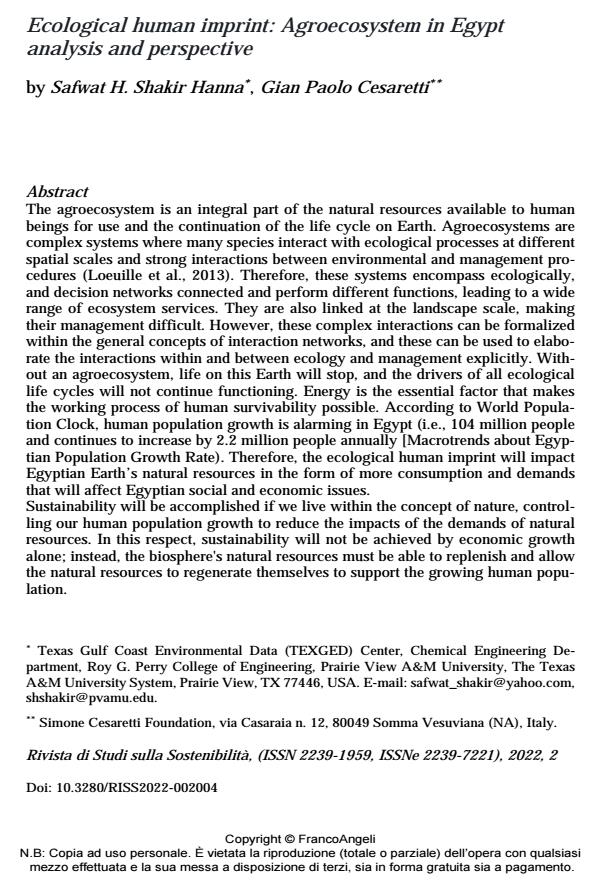Ecological human imprint: Agroecosystem in Egypt analysis and perspective
Titolo Rivista RIVISTA DI STUDI SULLA SOSTENIBILITA'
Autori/Curatori Safwat H. Shakir Hanna, Gian Paolo Cesaretti
Anno di pubblicazione 2023 Fascicolo 2022/2
Lingua Inglese Numero pagine 23 P. 41-63 Dimensione file 239 KB
DOI 10.3280/RISS2022-002004
Il DOI è il codice a barre della proprietà intellettuale: per saperne di più
clicca qui
Qui sotto puoi vedere in anteprima la prima pagina di questo articolo.
Se questo articolo ti interessa, lo puoi acquistare (e scaricare in formato pdf) seguendo le facili indicazioni per acquistare il download credit. Acquista Download Credits per scaricare questo Articolo in formato PDF

FrancoAngeli è membro della Publishers International Linking Association, Inc (PILA)associazione indipendente e non profit per facilitare (attraverso i servizi tecnologici implementati da CrossRef.org) l’accesso degli studiosi ai contenuti digitali nelle pubblicazioni professionali e scientifiche
The agroecosystem is an integral part of the natural resources available to human beings for use and the continuation of the life cycle on Earth. Agroecosystems are complex systems where many species interact with ecological processes at differ-ent spatial scales and strong interactions between environmental and management procedures (Loeuille et al., 2013). Therefore, these systems encompass ecological-ly, and decision networks connected and perform different functions, leading to a wide range of ecosystem services. They are also linked at the landscape scale, making their management difficult. However, these complex interactions can be formalized within the general concepts of interaction networks, and these can be used to elaborate the interactions within and between ecology and management explicitly. Without an agroecosystem, life on this Earth will stop, and the drivers of all ecological life cycles will not continue functioning. Energy is the essential factor that makes the working process of human survivability possible. According to World Population Clock, human population growth is alarming in Egypt (i.e., 104 million people and continues to increase by 2.2 million people annually [Macro-trends about Egyptian Population Growth Rate). Therefore, the ecological human imprint will impact Egyptian Earth’s natural resources in the form of more con-sumption and demands that will affect Egyptian social and economic issues. Sustainability will be accomplished if we live within the concept of nature, control-ling our human population growth to reduce the impacts of the demands of natu-ral resources. In this respect, sustainability will not be achieved by economic growth alone; instead, the biosphere's natural resources must be able to replenish and allow the natural resources to regenerate themselves to support the growing human population. Egypt’s agroecosystems are facing declining fertile lands, reduction in water re-sources, and expansion of the human population on the agricultural lands for housing and other activities without control. The concentration of the Human Population of Egypt is occupying 4-5% of the total land. It is due to the lack of infrastructure available in the rest of the lands of Egypt (i.e., 96- 97% is desert ex-cept around the river Nile). The Ecological Human Imprint (EHI), as indicated by Shakir Hanna et al. 2017, is a measuring tool for assessing the carrying capacity of an area regarding the use of the planet's natural resources. Therefore, the "Egyp-tian Agroecosystem Human Imprint Assessment (EAHIA) Model" (Shakir Hanna, 2021) indicates the magnitude of the impact of the growing human population on the agroecosystems of Egypt. In addition, the model predicts that the human pop-ulation will reach 187 million people in the year 2050 and may be double by the year 2100 in a reasonable assumption of increased human population growth rate at 1.1%; otherwise, there will be disastrous conditions and the spread of the "Hun-ger Revolution." In addition, the model will calculate the agroecosystem lands, water resources availability, and their production and productivity and economy in Egypt. It predicts the changes and impacts of agriculture systems economically and socially in Egypt and promotes conservation to save agricultural lands from deterioration.
Parole chiave:Egyptian Agroecosystem Human Imprint Assessment (EAHIA) Mod-el, sustainable development, human population, human imprint.
Safwat H. Shakir Hanna, Gian Paolo Cesaretti, Ecological human imprint: Agroecosystem in Egypt analysis and perspective in "RIVISTA DI STUDI SULLA SOSTENIBILITA'" 2/2022, pp 41-63, DOI: 10.3280/RISS2022-002004